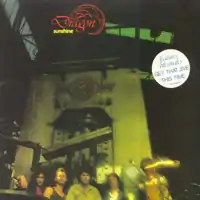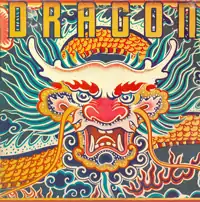Sunshine (Dragon album)
Sunshine is the third studio album by New Zealand[1] rock band Dragon, it was their first album after they had relocated to Sydney, Australia in May 1975.[2][3][4] Sunshine was released in February 1977 by CBS Records and peaked at #24 on the Australian national albums charts.[5] The album was certified gold.[6] The single "This Time" had been released in late June 1976, which peaked at #26 on the Australian national singles charts.[5] The second single "Get that Jive" was the best charting peaking at #13 and the third single "Sunshine" reached #36.[5] The album had US and International releases in 1978 on Portrait Records, with "This Time" called "In the Right Direction" and an alternative cover used (see infobox).
| Sunshine | ||||
|---|---|---|---|---|
 Original 1977 cover | ||||
| Studio album by | ||||
| Released | February 1977 1978 International release | |||
| Genre | Pop rock | |||
| Length | 38:32 | |||
| Label | CBS Portrait | |||
| Producer | Peter Dawkins | |||
| Dragon chronology | ||||
| ||||
| Singles from Sunshine | ||||
| ||||
| Sunshine | ||||
 1978 International release | ||||
Dragon had released two progressive rock albums in New Zealand but in Sydney they were moving to a pop rock sound and sent for keyboardist Paul Hewson of rival kiwi group Mammal.[4] Hewson joined Dragon with Marc Hunter on vocals and his older brother Todd Hunter on bass guitar, Neil Storey on drums and Robert M. Taylor on lead guitar.[7] Storey died of heroin overdose in September 1976, aged 22.[8][9][10] Their debut single "This Time" had begun charting, they considered disbanding but continued with ex-Mammal drummer Kerry Jacobson to complete the album.[4] The album was dedicated to Neil Storey (1954–1976).
Background
After Dragon relocated to Sydney in May 1975 they landed a contract with CBS Records when record producer Peter Dawkins caught one of their performances.[3][4][8] Dragon co-founder Ray Goodwin left the group in 1975, so Dragon sent for keyboard player Paul Hewson who had a reputation, in New Zealand, as a pop songwriter.[4] Hewson, ex-Mammal, had been scouted by Dragon when they were still in New Zealand but had declined to join.[4] Often courting or creating controversy, the band was rocked by the heroin overdose death of drummer Neil Storey in September 1976, aged 22.[8][9][10] By then, their debut single "This Time" had begun charting.[8] After considering disbanding, Todd Hunter consulted with former manager Graeme Nesbitt (ex-Mammal) who advised him to continue and organised for Kerry Jacobson (ex-Mammal) to join on drums.[4]
Reception
Rip It Up noted that the song-writing in the band had matured, saying, "A few might argue that Dragon, in adopting a more commercial format, have forsaken their Art: a few more may grumble about the weaker songs on side two, but I for one see their adoption of a tried and true style as good discipline."[11]
Track listing
Australian/New Zealand release
All songwriters according to Australasian Performing Right Association (APRA).[12]
- "Same Old Blues" (Paul Hewson) - 4:54
- "Blacktown Boogie" (Marc Hunter, Robert M. Taylor, Todd Hunter) - 3:15
- "Sunshine" (Hewson) - 4:50
- "On the Beachead" (Taylor) - 3:59
- "This Time" (Hewson, M Hunter, Neil Storey, Taylor, T Hunter) - 3:07 ^^
- "Get that Jive" (Hewson) - 2:44
- "Street Between Your Feet" (M Hunter, Taylor) - 4:19
- "New Machine" (Hewson) - 3:47
- "MX" (M Hunter, Taylor) - 3:28
- "The Letter" (M Hunter, Taylor) - 4:09
International release
- "Same Old Blues" (Hewson) - 4:54
- "Blacktown Boogie" (M Hunter, Taylor, T Hunter) - 3:15
- "Sunshine" (Hewson) - 4:50
- "On the Beachead" (Taylor) - 3:59
- "In the Right Direction" (Hewson, M Hunter, Storey, Taylor, T Hunter) - 3:07 ^^
- "Get that Jive" (Hewson) - 2:44
- "Street Between Your Feet" (M Hunter, Taylor) - 4:19
- "New Machine" (Hewson) - 3:47
- "MX" (M Hunter, Taylor) - 3:28
- "The Letter" (M Hunter, Taylor) - 4:09
(^^) "This Time" was renamed "In the Right Direction" for International release but is otherwise the same.
Charts
| Chart (1977) | Peak position |
|---|---|
| Australian Kent Music Report[13] | 24 |
Certifications
| Region | Certification | Certified units/sales |
|---|---|---|
| Australia (ARIA)[14] | Gold | 20,000^ |
|
^ Shipments figures based on certification alone. | ||
Personnel
Credited to:[15]
Dragon
- Paul Hewson – keyboards
- Marc Hunter – lead vocals
- Todd Hunter – bass guitar
- Kerry Jacobson – drums (except "This Time")
- Neil Storey – drums on "This Time"
- Robert M. Taylor – guitars (electric, acoustic)
Additional musicians
- Tony Buchanan – tenor saxophone on "Sunshine"
- William Motzing – brass arranger
Recording
- Producer – Peter Dawkins
- Engineer – Bruce Brown @ Albert Studio
- Additional engineering – Wyn Wynard
- Manager – Sebastian Chase
Artwork
- Art Direction & Design – J. Peter Thoeming
- International release, Illustrator – Julia van Henneside
- International release, Design – Nancy Donald, Tim Stocke
- International release, Inner sleeve logo – Andy Capel
- Cover Photography – Carroll Holloway
References
- "Dragon | NZ Music Hall of Fame". Retrieved 12 February 2022.
- "ARIA Hall of Fame - Dragon". Australian Recording Industry Association (ARIA). 22 May 2008. Archived from the original on 19 July 2008. Retrieved 23 August 2008.
- "Groups & Solo Artists - Ariel". Milesago. Retrieved 23 August 2008.
- "Dragon". Bruce Sergent. Archived from the original on 4 October 2009. Retrieved 23 August 2008.
- Kent, David (1993). Australian Chart Book 1970-1992. St Ives, N.S.W.: Australian Chart Book. ISBN 0-646-11917-6. NOTE: Used for Australian Singles and Albums charting from 1970 until ARIA created their own charts in mid-1988.
- "Dragon - Power Play (1979) + Bonus Single". Rock on Vinyl. 24 October 2016. Retrieved 21 January 2018.
- "Dragon". Australian Rock Database. Passagen.se (Magnus Holmgren). Archived from the original on 22 October 2013. Retrieved 21 March 2014.
- Nimmervoll, Ed. "Dragon". Howlspace – The Living History of Our Music (Ed Nimmervoll). Archived from the original on 26 July 2012. Retrieved 10 February 2014.
- "Marc Hunter (1953-1998)". MILESAGO. Retrieved 23 August 2008.
- "Dragon history". Dragon Online. Retrieved 23 August 2008.
- Bruce Belsham (1 August 1977). "Records". Rip It Up. No. 3.
- "APRA search engine". APRA. Archived from the original on 24 January 2008. Retrieved 23 August 2008. Note: requires user to input song title e.g. SAME OLD BLUES
- Kent, David (1993). Australian Chart Book 1970–1992. St Ives: Australian Chart Book. p. 94. ISBN 0-646-11917-6. N.B. The Kent Report chart was licensed by ARIA between mid-1983 and 19 June 1988.
- "Dragon - Power Play (1979) + Bonus Single". Rock on Vinyl. Retrieved 21 January 2018.
- "Images for Dragon (5) - Dragon". Discogs. Retrieved 23 August 2008. Note: some details also taken from Sunshine album cover notes